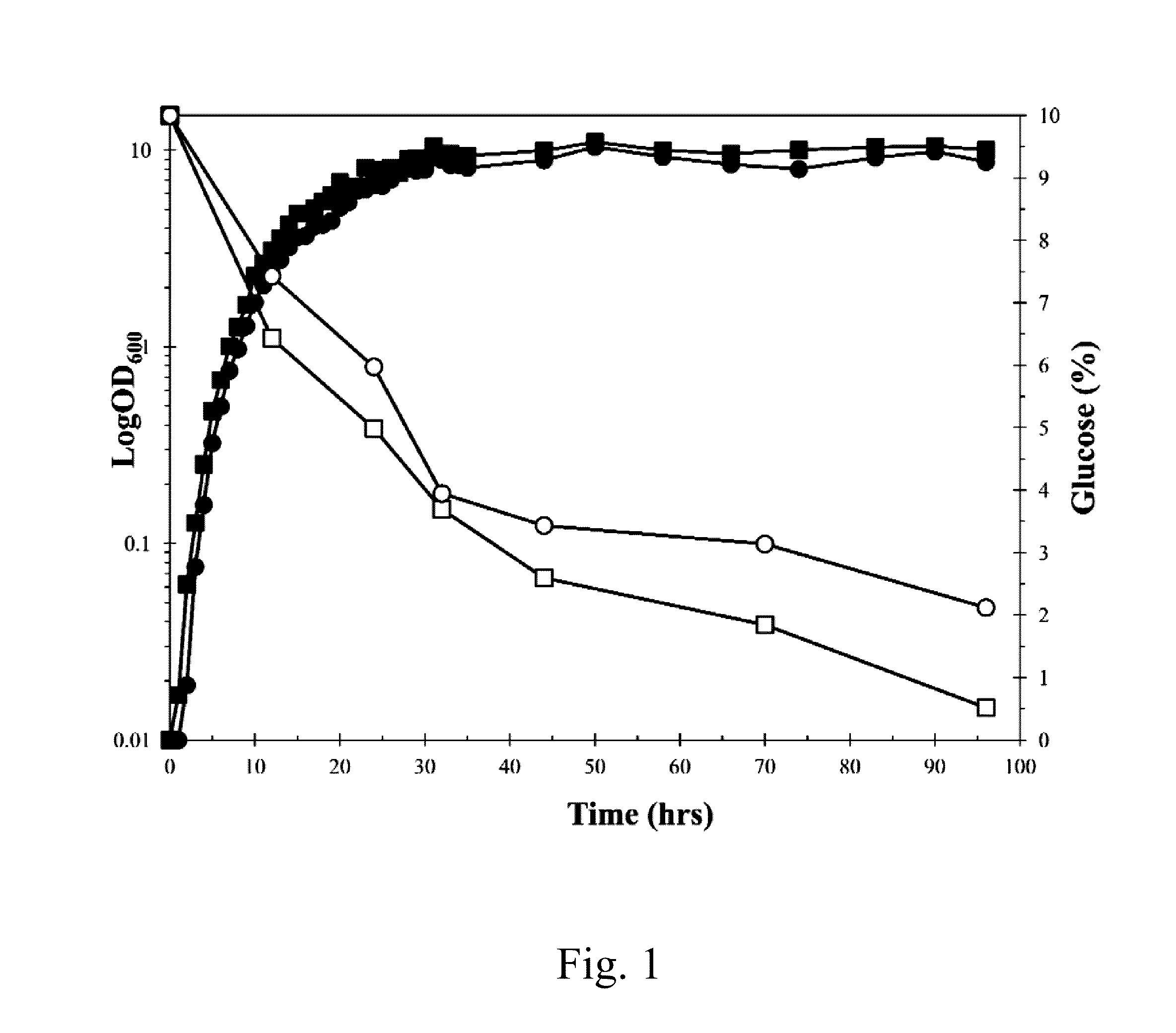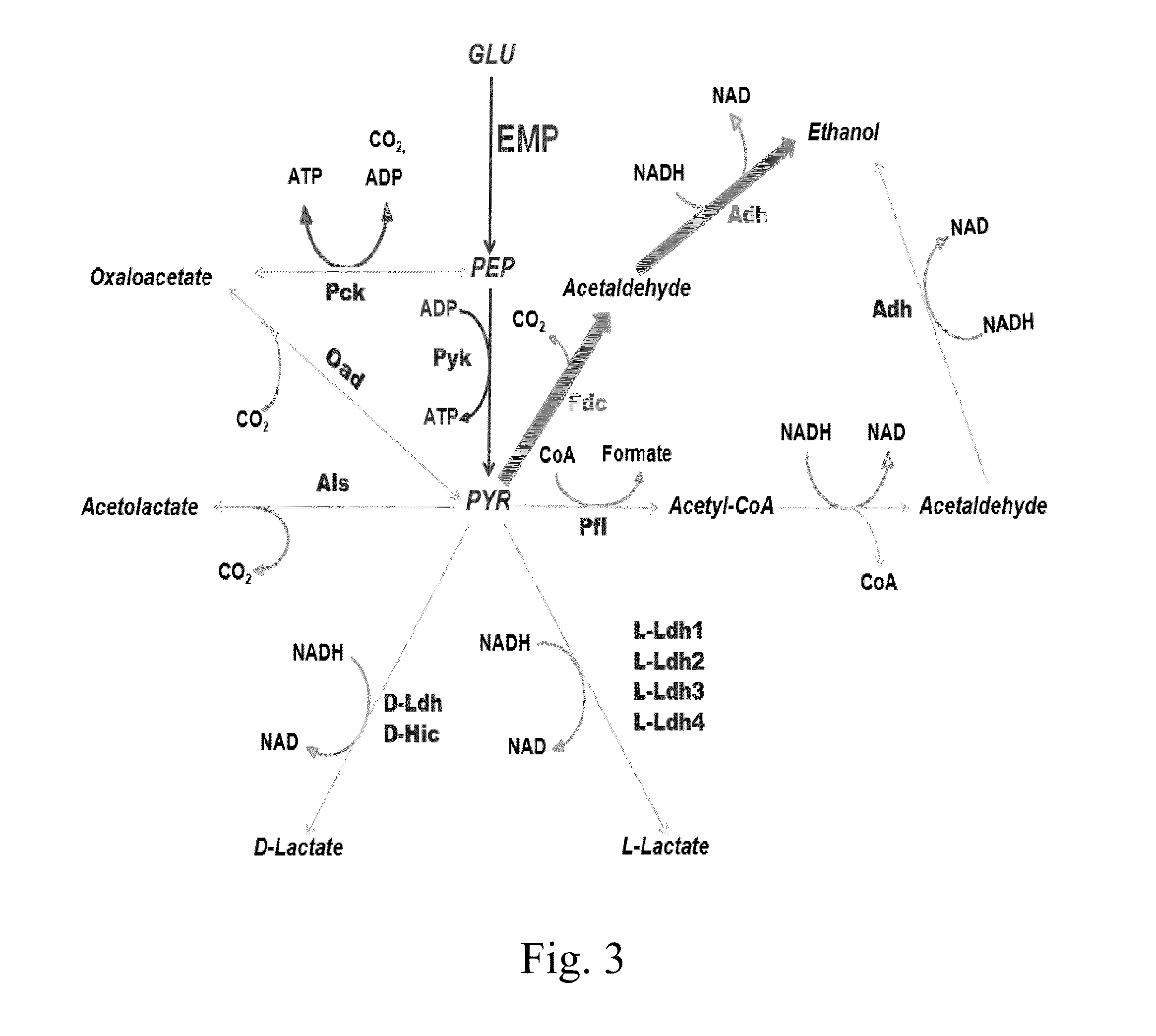Construction of a lactobacillus casei ethanologen
a technology of lactobacillus and ethanologen, which is applied in the field of synthetic lactobacillus casei bacterium, can solve the problems of poor availability of genetic tools, complex physiology, and low tolerance to environmental stresses
- Summary
- Abstract
- Description
- Claims
- Application Information
AI Technical Summary
Benefits of technology
Problems solved by technology
Method used
Image
Examples
example a
[0031]This example addresses (1) what level of carbohydrate Lactobacillus casei 12A derivatives are capable of using; and (2) what level of ethanol production takes place at elevated glucose concentrations.
[0032]In the first experiment, 48 small volume (2 ml) fermentations were conducted in GC vials containing our L. casei chemically defined media to examine glucose utilization and end product formation. In parallel, these fermentations were conducted in a 96 well plate reader to monitor growth. The experimental matrix was: 3 levels of glucose (2.5, 5.0, and 10% w / v), with and without the osmoprotectants present in ACSH (0.7 mM betaine, 0.7 mM choline chloride, and 0.2 mMDL-carnitine), with and without 2.5 μg / ml erythromycin (Ery) to select for the plasmid encoded PET cassette, and four different strains. The strains utilized were: (1) an L. casei 12A derivative (12AΔL-ldh1) lacking L-lactate dehydrogenase 1 (L-ldh1), the primary fermentative lactate dehydrogenase, with pTRKH2 (empt...
example b
[0038]This example shows the analysis of the data we obtained from the fermentations with 10% glucose with osmoprotectants and Ery that were conducted in our larger scale (500 ml) fermentation equipment with Lactobacillus casei 12AΔL-ldh (pPPGM-PET) and 12AΔL-ldh1ΔLldh2ΔD-hic (pPPGM-PET) at 37° C., with pH maintained at 6.0. We could only accommodate three fermentation vessels at a time. Therefore, only the 12AΔL-ldh (pPPGM-PET) fermentation was conducted in duplicate.
[0039]The growth, glucose utilization, and ethanol production shown by these strains are presented in FIGS. 2A (L. casei 12AΔL-ldh (pPPGM-PET)) and 2B (L. casei 12AΔL-ldh1ΔLldh2ΔD-hic (pPPGM-PET)). The growth of the two strains under these conditions was indistinguishable. However 12AΔL-ldh (pPPGM-PET) utilized a greater quantity of glucose and produced more ethanol than 12AΔL-ldh1ΔL-ldh2ΔD-hic (pPPGM-PET). The glucose utilization and ethanol formation obtained with 12AΔL-ldh (pPPGM-PET) in the larger fermentation vess...
example c
Screening Strains of L. casei for Biofuels Relevant Phenotypes and Genes
[0043]Our laboratory has a culture collection contains approximately 60 strains of L. casei isolated from green plant material (i.e. corn silage), cheese, wine, and humans. The eleven strains with genome sequences were screened for the ability to utilize 60 different carbohydrates, including numerous carbohydrates present in lignocellulosic feed stocks. Individual strains were able to grow on between 17 and 26 different substrates. The strains isolated from corn silage (12A and 32G) grew on the greatest number of substrates. Nine gene clusters potentially involved in cellobiose utilization and one gene cluster involved in xylose utilization were identified.
[0044]The eleven strains with genomic information were also screened for alcohol tolerance (ethanol, 1-propanol, 1-butanol, and 2-methyl-1-butanol), growth in AFEX-pretreated corn stover hydrolysate (ACSH), and transformation (electroporation) efficiency. L. c...
PUM
| Property | Measurement | Unit |
|---|---|---|
| optical density | aaaaa | aaaaa |
| time | aaaaa | aaaaa |
| osmolarity | aaaaa | aaaaa |
Abstract
Description
Claims
Application Information
 Login to View More
Login to View More - R&D
- Intellectual Property
- Life Sciences
- Materials
- Tech Scout
- Unparalleled Data Quality
- Higher Quality Content
- 60% Fewer Hallucinations
Browse by: Latest US Patents, China's latest patents, Technical Efficacy Thesaurus, Application Domain, Technology Topic, Popular Technical Reports.
© 2025 PatSnap. All rights reserved.Legal|Privacy policy|Modern Slavery Act Transparency Statement|Sitemap|About US| Contact US: help@patsnap.com



